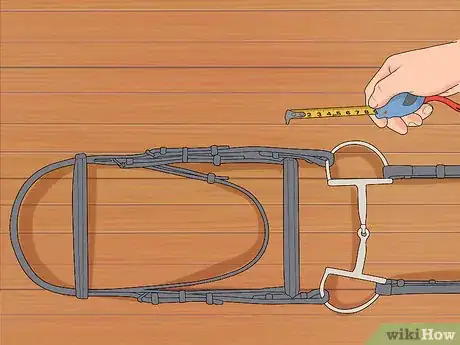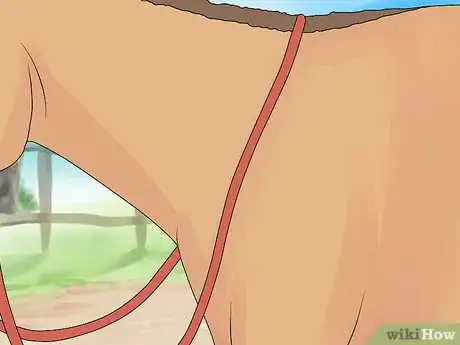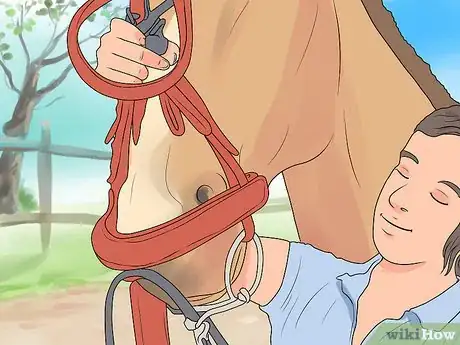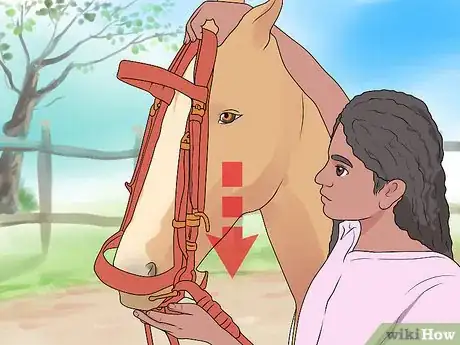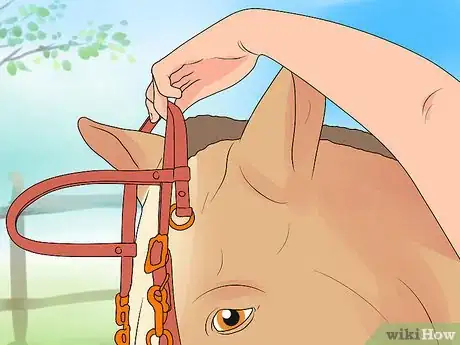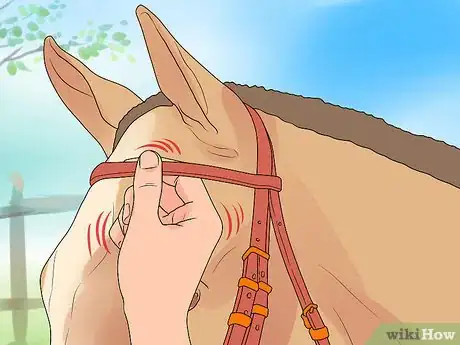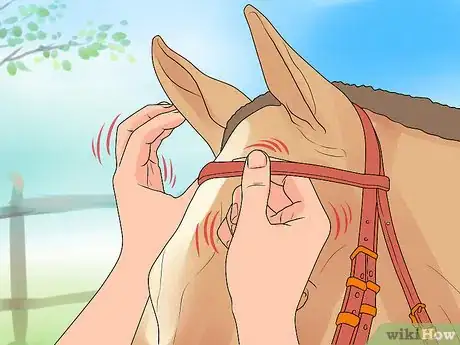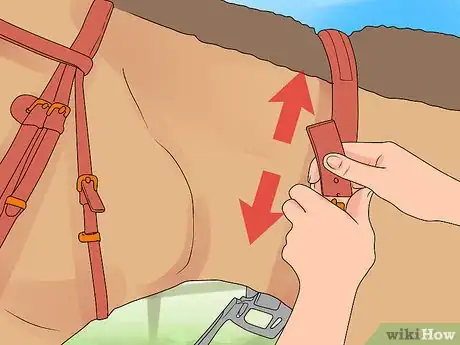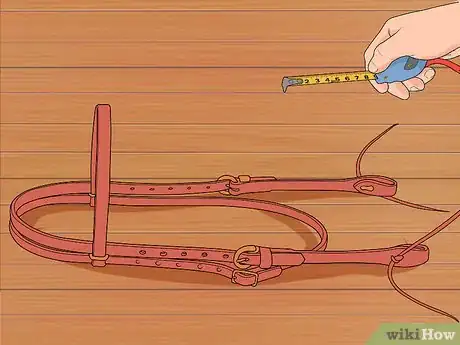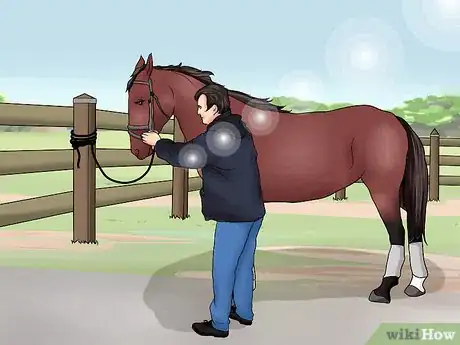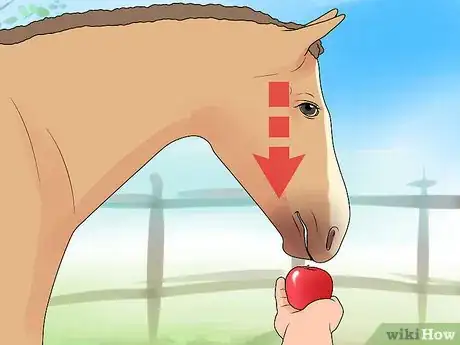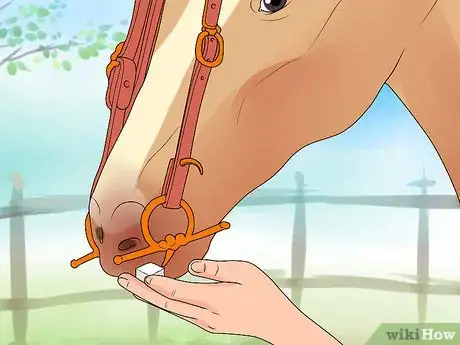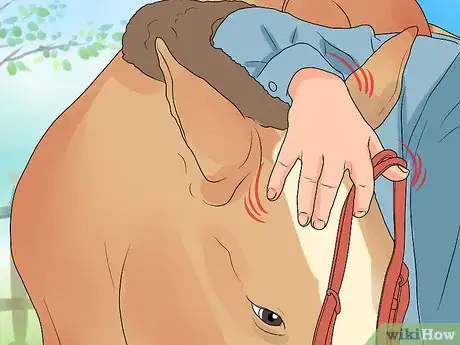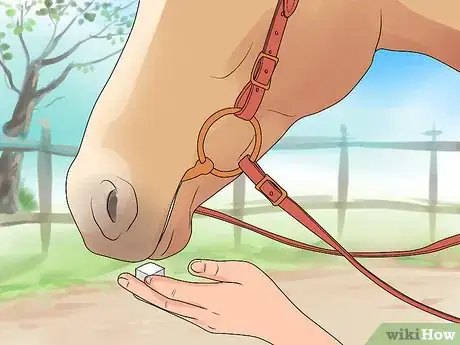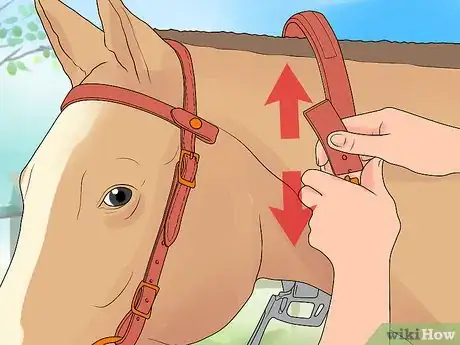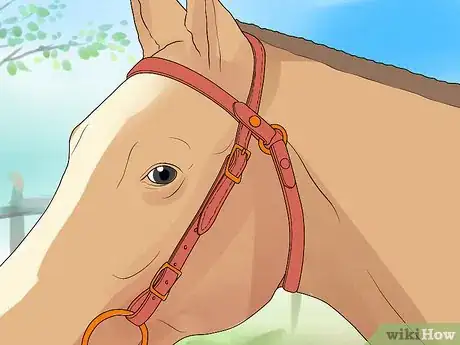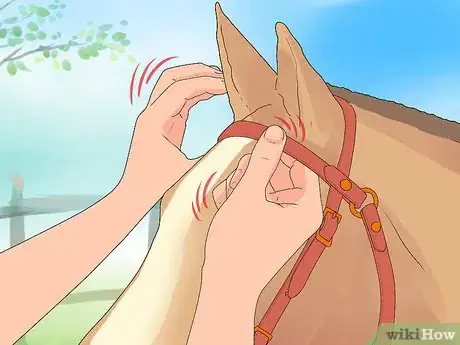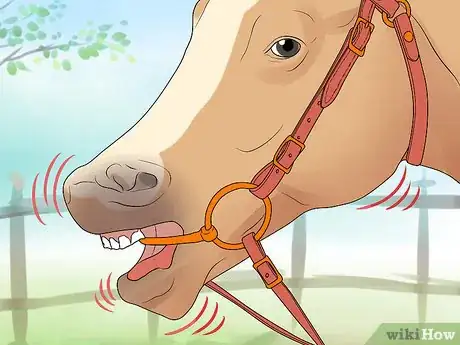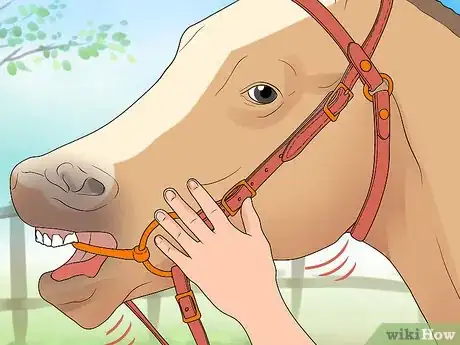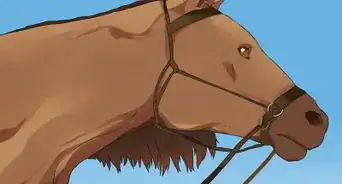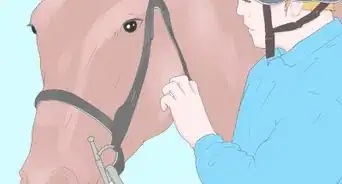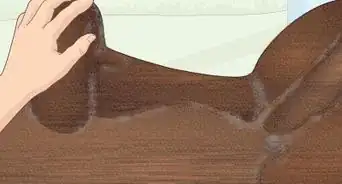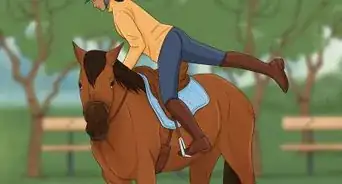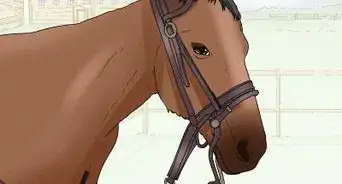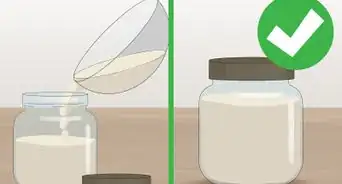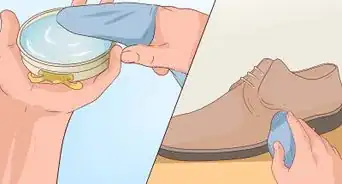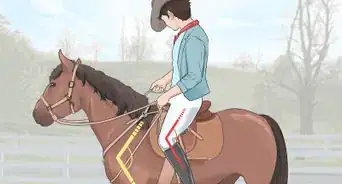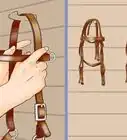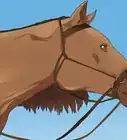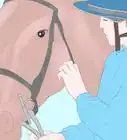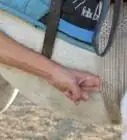wikiHow is a “wiki,” similar to Wikipedia, which means that many of our articles are co-written by multiple authors. To create this article, 42 people, some anonymous, worked to edit and improve it over time.
There are 10 references cited in this article, which can be found at the bottom of the page.
This article has been viewed 162,118 times.
Learn more...
When riding, a bridle provides you with the ability to cue the horse, letting the horse know what you'd like it to do. Bridling can be confusing at first, but is easy once you learn it. Part of successfully bridling a horse is to take care that the bridle does not cause discomfort to the horse.
Steps
Bridling with an English Bridle
-
1Check that you have the correct bridle size. If this is the first time you're using this bit on this particular horse you should be sure that you're using a proper sized bridle. If it's the wrong size it will make the horse uncomfortable.[1]
- Bridles comes in three sizes: pony, cob or Arabian, and full. Measure your horse’s head from the center of his poll to the corner of his mouth, and compare this measurement to the crown and cheek piece of the bridle.
- If the bit is too small it can pinch the horse’s mouth.
- If the bit is too large it will slide around in the horse’s mouth. Also an over-sized ported or jointed bit can cause pain or damage to the roof of the horse's mouth.
-
2Halter your horse so the main part is around the horse's neck. (Let the noseband hang.) This gives you something to keep the horse in check, but won't get in the way of the bridle. Do not have the horse tied when you do this.[2]Advertisement
-
3Pick up and position your bridle. Pick it up from its crownpiece (top part) in your left hand, letting the rest of it hang. Move any small straps to the outside of the cheekpieces, so they won't get tangled[3] .
-
4Drape the reins over your horse's neck.
-
5Switch hands holding the bridle. Now hold it in your right hand.[4]
- Hold the bridle so that the two sides are a good distance apart, with the crown up and the throatlatch straps hanging free and not tangled in any other straps.
- Make sure you take up all the reins so that you don’t create loops for your horse to step in and keep all the straps off the ground.
-
6Have the horse drop his head for the bit. Once he does, hold the bit in the palm of your left hand, with your right forearm paralleling the horse's top of his neck (your hand should be right near his ears). Gently press the bit next to the horse's teeth, and insert your thumb back into the horse's mouth to make it open if you must.[5]
- If your horse won't lower his head or accept the bit, stick your thumb in the back of its mouth this will get it open and is completely safe they have no teeth there! Or offer them a treat while offering the bit. Hold the bridle in your right arm with the crown of it near the horse's ears, and rest its bit and stick your thumb in the back of its mouth or a treat (a bit of apple or sugar cube) in your palm.
- Slip the bit into your horse’s mouth (with the treat if you choose to do it this way) . Hold the bit low where you’ve been holding the treats. Gently set it against your horse’s teeth as close to where her top teeth meet her lower teeth as possible. Hold your sugar cube against the bit.
- Make sure that you’re holding the crown up and ready to slip on before you put the bit in their mouth.
- Make sure you have the bit in before you put the bridle’s crown over their ears.
-
7Slip the crown of the bridle over the horse’s ears. You want to maintain gentle pressure on the bit so the horse doesn't let it out of his mouth. Avoid crushing the horse's ears. It you have to slip one ear under the crown and then the other, do so gently.
- Give your horse a treat to reward them for being good. This is optional, and probably not needed for a calm, experienced horse.
-
8Adjust the brow band. The brow band should always rest against your horse's forehead smoothly. It should be set 1-2" below the base of the horse's ears. Check from the front to make sure it's straight and isn't pinching the horse's ears.
- While you're adjusting the brow band, adjust the headstall and cheek pieces to make sure everything is straight. Double check by looking at the bridle head-on.
-
9Buckle the throatlatch. The throatlatch isn't there to hold the bridle in place, and should be buckled with enough slack for 4 fingers to slide between it and the horse's neck. The throatlatch operates as an extra precaution to prevent the bridle from falling off. This means that the throatlatch needs to be loose enough to maintain slack, even if the horse drops his head.[6]
- Make sure you can fit 4 fingers between the throatlatch and the horse, even when their head is bent downwards. To remember about how loose the throatlatch should be, imagine it as a necklace.
-
10Check the fit of the bridle. The brow band should be smooth and in the correct position (so it won't be pinching your horse's ears or head). Check that the bit sits evenly in your horse's mouth. There should be two wrinkles on either corner of your horse's mouth. Too few wrinkles and you need to shorten the cheek straps.[7]
- Make sure it sits evenly on your horse’s head. If you do have to adjust the cheek strap check that the rest of the headstall is still even.
-
11Remove the halter once you’re satisfied with the bridle’s positioning. Unsnap the halter from the remaining cross-tie. Untie the lead rope from your horse's neck and unbuckle and remove the halter.[8]
- This is when you should check the length of your reins. The need to be long enough that you can take up contact with your horse's mouth.
-
12Hold your horse by sliding the reins from their neck and gathering them in your hand. Lead them on their left, at their cheek. Hold the reins in your right hand about six inches below the bit.[9]
- Keep the bight in your left hand.
Bridling With a Western Bridle
-
1Pick Western style riding for more informal riding. People tend to use Western style riding for rodeos and ranching and it is more common in the U.S. than in other countries, so you might have a harder time accessing Western equipment if you live somewhere that favors English style.
- One nice thing about the Western saddle is that it has the horn, where you can hold on, if you are concerned about falling off. It can also help you to feel balanced.
-
2Check that you have the correct bridle size. If this is the first time you're using this bit on this particular horse you definitely want to make sure that you're using the proper sized bridle. If it's the wrong size it will make the horse uncomfortable.[10]
- Bridles comes in three sizes: pony, cob or Arabian, and full. Measure your horse’s head from the center of his poll to the corner of his mouth, and compare this measurement to the crown and cheek piece of the bridle.
- If the bit is too small it can pinch the horse’s mouth.
- If the bit is too big it will slide around in the horse’s mouth.
-
3Make sure that both you and the horse are calm. A horse can sense your fear and this will make them nervous. Also, remember that it can be nerve-wracking for a horse to have someone putting something metallic in their mouth.
-
4Secure your horse. You need to make sure that your horse is secured. This means anticipating the moment when they are halter-free but you haven't yet buckle the bridle. You have to be able to control and keep hold of your horse.[11]
- For a tie station, hold the bridle so that the front of the brow band faces forward (away from the horse). Drape the reins over their neck. Drop your left rein over the horse's neck so that it falls on the right. Drop the right rein so that it falls on the left. Allow the bridle to slip back on your arm. Lift the crown of the halter over the horse's ears and slip the halter's nose band down, off their face. Bring the crown up and lay it behind their ears. Refasten their halter so it hands around the horse's neck.[12]
- If you don't have a tie station use the bridle reins to maintain hold of your horse. For split reins, tie them together and lift the reins over the horse's head, setting them just behind their ears. Lift the halter's crown over the horse's ears and slip the halter nose band off your horse's face. [13]
-
5Have your horse drop their head. You can offer them a piece of apple or sugar cube to make them their head. Put your hand right below their nose with the treat in it. When they drop their head that's when you'll put the bit in.
- Make sure you’re grasping the crown of the bridle in your right hand. Angle in line with your horse’s left eye and right ear.
-
6Slip the bit into your horse’s mouth with the treat. Hold the bit low where you’ve been holding the treats. Gently set it against your horse’s teeth as close to where her top teeth meet her lower teeth as possible. Hold your sugar cube against the bit.
- Make sure you put the bit in before you put the bridle’s crown over their ears.
- Holding the crown of the bridle up in order to slip it on before you put the bit in their mouth.
- Hold the bridle so that the two sides are a good distance apart, with the crown up and the throatlatch straps hanging free and not tangled in any other straps..
-
7Keep pressure on the crown while slipping it over their ears. You want to be careful that you don't crush your horse's ears. Lift the crown over your horse's left ear as you slip the crown to the poll. Gently slip the horse's right ear in front of the crown as well. Also gently push the horse's ears forward rather than backward.[14]
- If the bridle has earloops rather than a brow band, position these around your horse’s ears now.
-
8Give your horse a treat for being good. Always make sure that you reward your horse for their good behavior. This will encourage them to be good about accepting the bit and the bridle.
- Sugar also encourages them to play with the bit, so sugar cubes are a really good treat to have on hand for bridling.
-
9Remove the halter once the main part of the bridle is on the horse.[15]
-
10Buckle the throatlatch. Remember that the throatlatch isn't there to hold the bridle in place. It operates as an extra precaution against the bridle coming off. This means that the throatlatch needs to be loose enough to maintain slack, even if the horse drops their head.[16]
- Make sure you can fit your entire hand between the throatlatch and the horse, even when their head is bent towards their neck.
-
11Check the bridle's fit. The brow band should be smooth and in the correct position. This means it won't be pinching your horse's ears or head. Check that the bit sits evenly in your horse's mouth. There should be two wrinkles on either corner of your horse's mouth. Too fewer and you need to shorten the cheek straps.[17]
- Make sure it sits evenly on your horse’s head. If you do have to adjust the cheek strap check that the rest of the headstall is still even.
- Buckle curb chain or chin strap if that isn’t fixed.
- This is when you should check the length of your reins. The need to be long enough that you can take up contact with your horse's mouth.
-
12Gather your reins in your right hand. Lead them on their left, at their cheek. Hold the reins in your right hand about six inches below the bit. Keep the bight in your left hand. Always hold about six inches below the bit.[18]
- Keep the slack from the reins in your left hand.
Troubleshooting
-
1Deal with a horse that objects to the bit. Often the reason a horse objects to the bit is rooted in misunderstanding. They aren't usually trying to be naughty, but something about the bit is making them uncomfortable.
- The bit might have the wrong taste. Horses tend to prefer copper bits to other kinds of bits because of the taste. Unfortunately copper bits tend to degrade more quickly than other kinds so you should make sure to watch out for pits and sharp edges.
- The bit might be too cold. You wouldn't want someone to shove a bit of cold metal in your mouth. Neither does your horse. Try warming up the bit between your hands before you put it in their mouth.
-
2Train your horse to open their mouth for the bit. Sometimes your horse won't open their mouth, because the bit is too cold, or has the wrong taste, but often a little training can make it so they will do as you has. Just make sure that you reinforce the behavior you want to see from them.
- Teach your horse to be comfortable with the cue. Pick a cue to use to get your horse to open their mouth. Give your horse the cue by touching them. Say "yes" to them so that they associate that touch with good behavior. Give your horse a treat as you take your fingers away.
- Show your horse that they get a treat. Have your horse tied or secured. Approach the horse's head from the left side, and walk so that your horse can see you. Stay on an angle facing the same direction as your horse. Have a treat in your left hand. Give your horse the cue and say "Open," while gently pressing two fingers again their lower lip. Say "yes" and take your fingers away, giving your horse the treat.
- Repeat these steps about four or five times, or until it seems like your horse has gotten the picture.
- Now do as you did above, only this time maintain slight but consistent pressure, and place your fingers just under his upper lip. When your horse opens their mouth say "Yes" and give them the treat. Practice this until they get it.
- Have your horse let you put a bit in their mouth. Show your horse the bit (unattached to the bridle to begin with). Let your horse sniff it and lip it. Then do as you did above, giving your horse the cue. Place the bit in your horse's mouth when they open up. Remove the bit and give them a treat.
-
3Keep your horse from getting nervous. One of the keys to properly bridling your horse is to maintain calmness, both in yourself and in your horse. A nervous horse might try to bite, toss their heads, strike out with their hooves, or try to escape. If your horse is overly nervous, don't bridle them until they have calmed down.[19]
- Avoid flicking her with the reins, especially around her eyes and ears, because this can cause a horse to become nervous or anxious.
Community Q&A
-
QuestionWhat happens if the bit hits the horses teeth?
 Community AnswerNothing should happen. As long as the horse has healthy teeth, the bit shouldn't cause a problem.
Community AnswerNothing should happen. As long as the horse has healthy teeth, the bit shouldn't cause a problem. -
QuestionWhat if the horse won't let me touch its head?
 Community AnswerTry starting from the withers to tell your horse that you're there, then slowly drag your hand up to the horse's face.
Community AnswerTry starting from the withers to tell your horse that you're there, then slowly drag your hand up to the horse's face. -
QuestionEvery time I try to have my horse accept the bit, she freaks out and rears. What do I do?
 Community AnswerI have a horse that does that too! Lets diagnose the situation: Did your horse have an accident when bridling? Did your horse get hit on the head? Is she head shy? Are you jerking the bit out of her mouth? If any of that did happen, she will think that's going to happen again. Take a little time each day to work with her on this. Start by letting her investigate the bit. Let her take her time with this. If she is good, rub her head with the bridle. When you start to put the bridle on, make sure you still have the halter and lead rope on her so if she rears, you can firmly but gently pull the rope with a sharp "NO!"
Community AnswerI have a horse that does that too! Lets diagnose the situation: Did your horse have an accident when bridling? Did your horse get hit on the head? Is she head shy? Are you jerking the bit out of her mouth? If any of that did happen, she will think that's going to happen again. Take a little time each day to work with her on this. Start by letting her investigate the bit. Let her take her time with this. If she is good, rub her head with the bridle. When you start to put the bridle on, make sure you still have the halter and lead rope on her so if she rears, you can firmly but gently pull the rope with a sharp "NO!"
Warnings
- Do not let your reins lie on the ground, because if the horse steps over them, he could become quickly entangled, putting you and the horse in danger.⧼thumbs_response⧽
- Never tether a horse using a bridle. Leather is not strong enough to withstand a horse pulling against it and if the bridle snaps, the metal pieces on it can become dangerous.⧼thumbs_response⧽
- Try not to walk behind a horse, unless you are keeping a safe distance. When picking it's hooves keep to the side of the horse.⧼thumbs_response⧽
- Horses can sometimes be unpredictable animals. If you are bridling one, you are dealing with its teeth, so take care.⧼thumbs_response⧽
References
- ↑ http://www.aspca.org/pet-care/virtual-pet-behaviorist/horse-behavior/bridling-your-horse-english-bridle
- ↑ http://www.cowboyway.com/HowTo/BridleAHorse.htm
- ↑ https://esc.rutgers.edu/fact_sheet/saddling-and-bridling-horses-safely/
- ↑ https://esc.rutgers.edu/fact_sheet/saddling-and-bridling-horses-safely/
- ↑ http://www.aspca.org/pet-care/virtual-pet-behaviorist/horse-behavior/bridling-your-horse-english-bridle
- ↑ http://www.aspca.org/pet-care/virtual-pet-behaviorist/horse-behavior/bridling-your-horse-english-bridle
- ↑ https://esc.rutgers.edu/fact_sheet/saddling-and-bridling-horses-safely/
- ↑ https://esc.rutgers.edu/fact_sheet/saddling-and-bridling-horses-safely/
- ↑ https://esc.rutgers.edu/fact_sheet/saddling-and-bridling-horses-safely/
- ↑ http://www.aspca.org/pet-care/virtual-pet-behaviorist/horse-behavior/bridling-your-horse-western-bridle
- ↑ https://www.youtube.com/watch?v=lqOEop37d_U
- ↑ https://cowgirlmagazine.com/tack-western-style/
- ↑ https://cowgirlmagazine.com/tack-western-style/
- ↑ https://www.crktrainingblog.com/horse-training/how-to-bridle-a-horse/
- ↑ https://www.crktrainingblog.com/horse-training/how-to-bridle-a-horse/
- ↑ https://www.lovehorsebackriding.com/how-to-bridle-a-horse.html
- ↑ https://www.lovehorsebackriding.com/bridling-a-horse.html
- ↑ https://www.lovehorsebackriding.com/bridling-a-horse.html
- ↑ https://www.horsetalk.co.nz/2017/04/12/show-ring-success-horse-calm/
About This Article
To bridle a horse with an English bridle, start by haltering the horse so you have more control over it. Make sure the main part of the bridle is around the horse's neck, with the nose band hanging, so it doesn't get in the way of the bridle. Then, drape the reins over the horse’s neck, and push the bit against its teeth to make it bite on it. Next, place the crownpiece over your horse’s ears, and make sure the brow band is resting on its brow a few inches below the ears. Finish by buckling the throat latch and removing the halter. For tips on how to bridle a horse using a Western bridle, read on!
